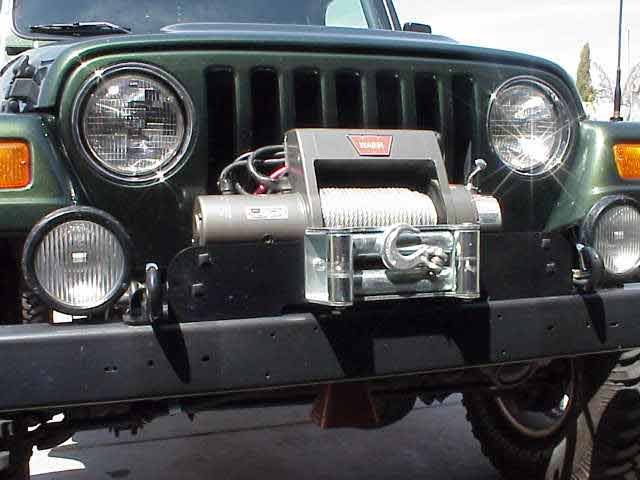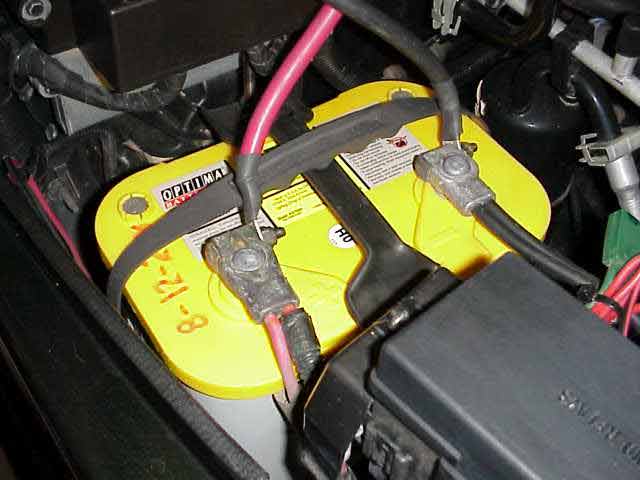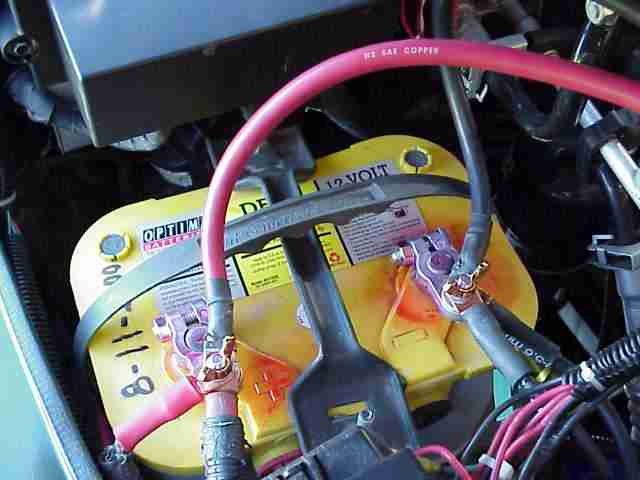The winch installation was about the easiest mod I have done to Lady. Since I bought the winch used, I needed some mounting hardware. Not being much of a fan of those blasted Torx bolts, I found this an excellent opportunity to replace them with some Grade 8 hex head bolts. A quick trip to the hardware store yielded the necessary 4 bolts and lock washers. I decided to recycle the metric bolt that holds down the front of the sway bar bracket. It was long enough to go through the winch mounting plate (and a couple of washers to act as a spacer) and still have plenty of threads left for a good hold. The only other item that requires removal is the plastic frame cover that has JEEP embossed into it. The winch plate goes right in that spot.

Here is winch after all the bolts were snugged up. Not too bad. I was happy that my factory fog lights did not require repositioning. (Every now and then you get lucky, I guess). I used 1/2-13 x 2.5″ bolts in place of the Torx 55s that where holding the aftermarket tow hooks in place. The tow hooks sit on top of the winch plate and the Grade 8s clamp everything down nice and tight.
I routed the power cables for the winch up along the side of the radiator and then back to the battery. I used a few cable ties to dress the power cables off neatly and to keep them out of any rotating parts.

I am not all together happy with this method of attaching the power cables to the battery, although it is probably sufficient to power the winch. I consider this a temporary setup for right now (I wanted to check the operation of the winch). Did you know that the folks from Optima will NOT warrantee the battery if you attach your winch to the side terminals. The side terminals are not designed to handle the high and lengthy current draw that a big winch can create.

Here is a response, from Optima tech support, to my question about using the side terminals on the Optima battery for my winch
8/27/2000
Stu,
Thank you for your interest in OPTIMA Batteries. The information you heard is correct. You don’t want to hook a winch up to the side terminals because the high current would short out the terminals causing your battery to fail. If you need any other information you can contact me at the above address.
Best Regards, Shana Holland
I would be willing to guess that the “short” that she mentions would more likely be an open. High current draw will cause a conductor to burn open if it can not handle the high current. Either way, it makes for a bad hair day for you. So….my plan is to cut the existing connectors off the end of the winch and vehicle cables. After that, I put 1/4″ ring terminals on the vehicle cables and attach them to the side posts. I’ll put post connectors on the winch cables and attach them to the top posts on the Yellow Top. I did confirm with Ms. Holland that I can attach my starter motor to the side terminals.

March 30, 2003
I finally got around to changing the connectors on my battery cables. Myself and a couple of good friends that normally all wheel together cut the factory ends off of our positive and negative terminals the other weekend. We installed crimp on ring terminals and attached them to a new pair of marine battery adapters. Why? Well, one of the guys bought himself a portable mig welder that runs off of either two or three 12 volt batteries that must be wired in series (to get either 24 or 36 volts). Scott had a chance to use it the other weekend but it was a hassle disconnecting all of the vehicle’s wiring when we hooked up his welder. The easy fix was to make it so that a wing nut need only be removed and the cables slipped off of the post and placed aside when the welding cables are attached.
Warn Motor Testing Procedure
If you find yourself in a situation where your winch is clicking but it is not working, you may have a motor problem….or you may have a solenoid problem. The following procedure, from Warn, will help you determine the status of your winch motor.
- Put the winch in freespool.
2. Disconnect the positive lead from the battery (leave the ground lead attached).
3. Label and disconnect the three cables that run from the control pack to the three posts on the motor.
4. Stamped next to the three posts on the motor will be “A”, “F1” and “F2”. Run a small jumper wire (5″-6″ dead lead, 8 ga. will work just fine) from “A” to “F1” and put power from the battery (jumper cables work good) to “F2”. The winch motor should run in one direction at this time.
5. Next, place the jumper wire from “A” to “F2” and put power from the battery to “F1”. The winch motor should run in the opposite direction at this time.
If these steps are followed correctly and the motor runs in both directions, the motor is good.
January 19, 2006
I spoke with BlaineJ last night, my buddy from CA that has assisted me on a couple of my projects over the years. We were discussing various topics and he passed along some information that he thought might go well with this write-up, and so here it is.
Blaine was out on the trail the prior week and a fella needed some assistance in getting his vehicle turned around on the trail. Another guy attached his winch to help accomplish the task. While winching, it was noticed that the winch (a Warn) was having difficulty in holding tension on the cable after letting off of the winch controller button. In other words, it appeared that the brake could not hold the load. It is indeed rare that you hear issues about Warn’s winch brake.
As Blaine came over to see what was happening, he immediately noticed that the winch cable was spooled onto the winch drum incorrectly…..it was wrapped around the drum going the wrong direction.
Blaine said he questioned the new Jeep owner (the guy had recently bought the Jeep and this was his first time using the winch) about it. The owner had noticed that the cable went the wrong way when he used the controller so his fix had been to take the switch out of the rubber controller handle and turn it around to match the graphics on the controller.
In doing so, the winch lost its ability to properly brake. The new owner didn’t realize that there is a right and wrong direction to spool the cable onto the winch drum. Once the rope was removed and correctly respooled, the brake works juat as it should. Of course, the individual then had to once again remove the switch from the controller and insert it the way it originally came from Warn.
Just something to remember if you happen to respool your winch rope/cable. Make sure it does on the correct way.
